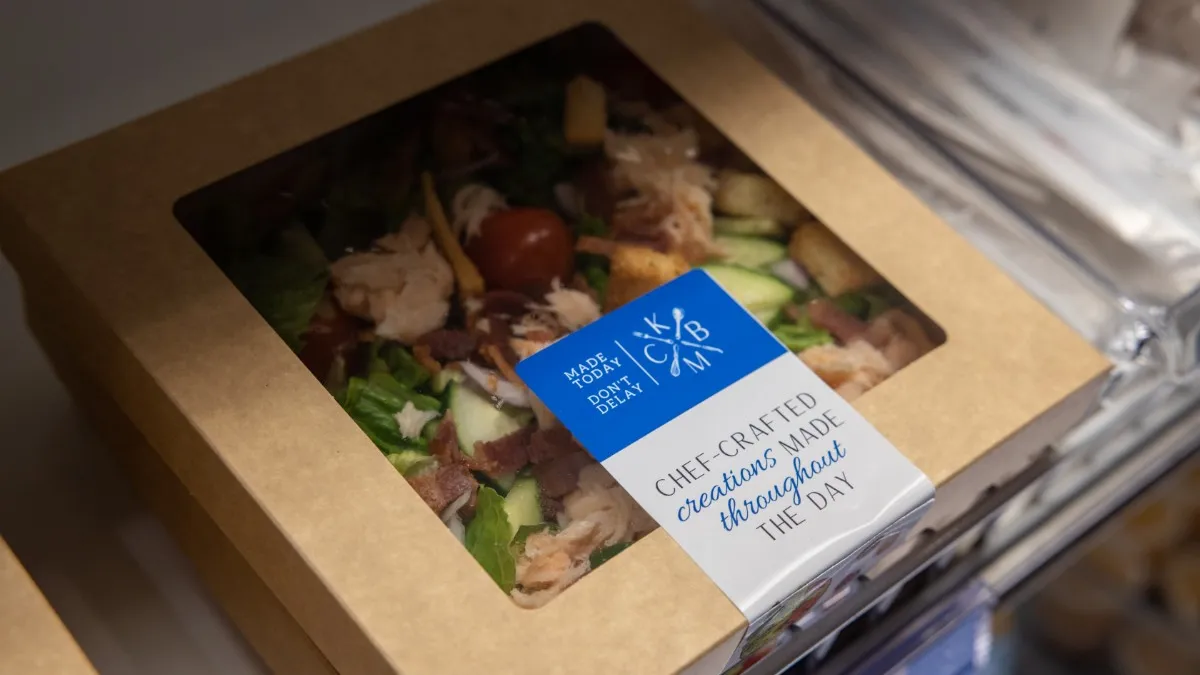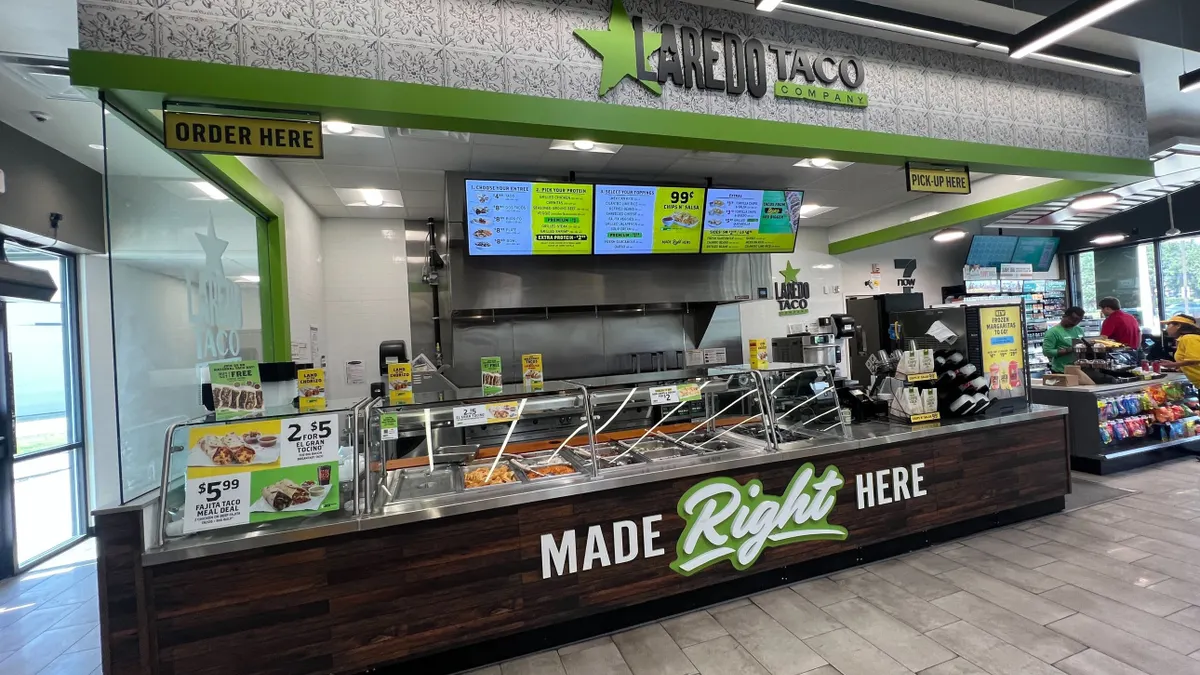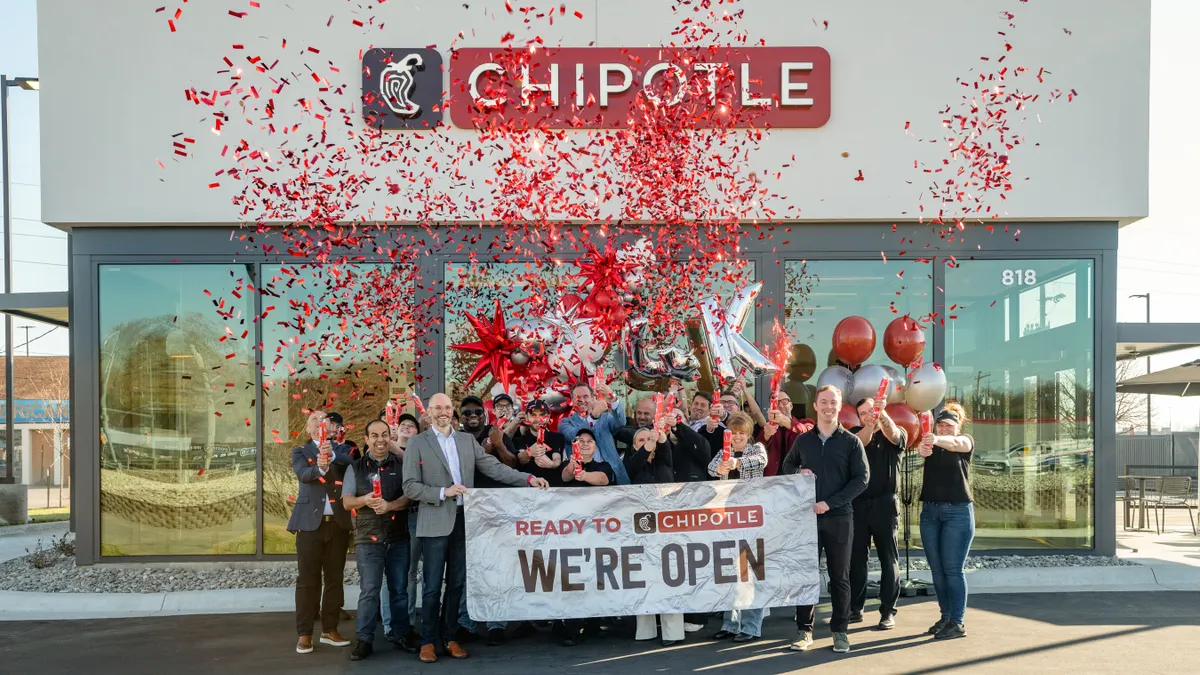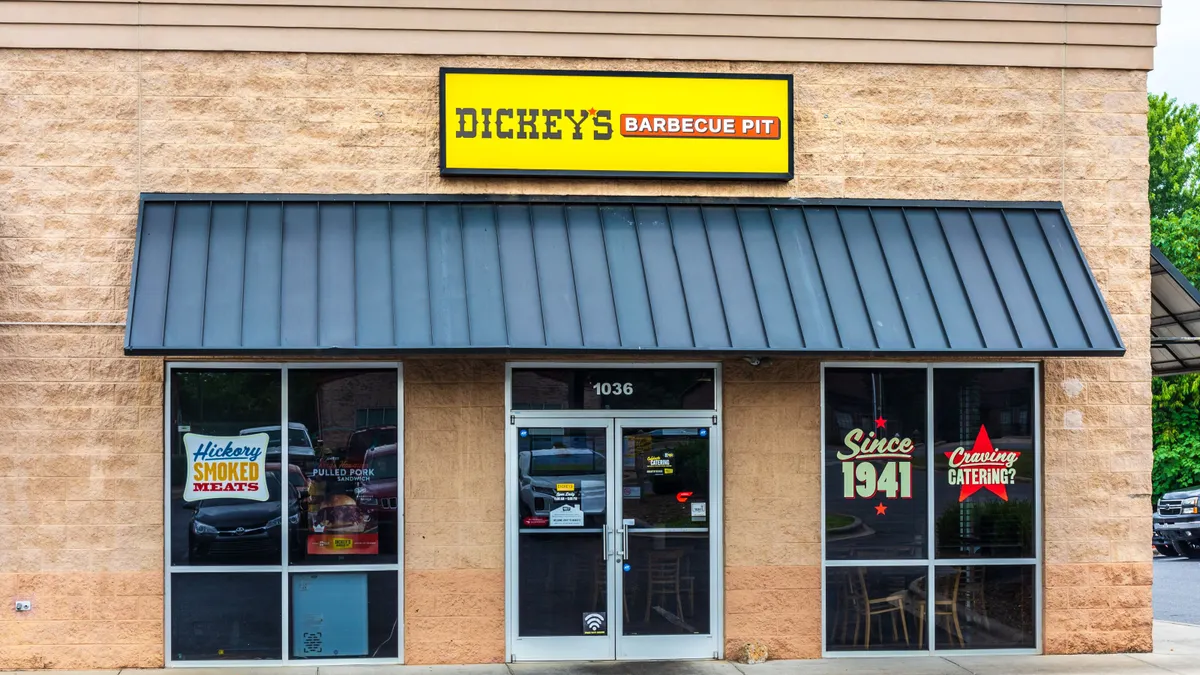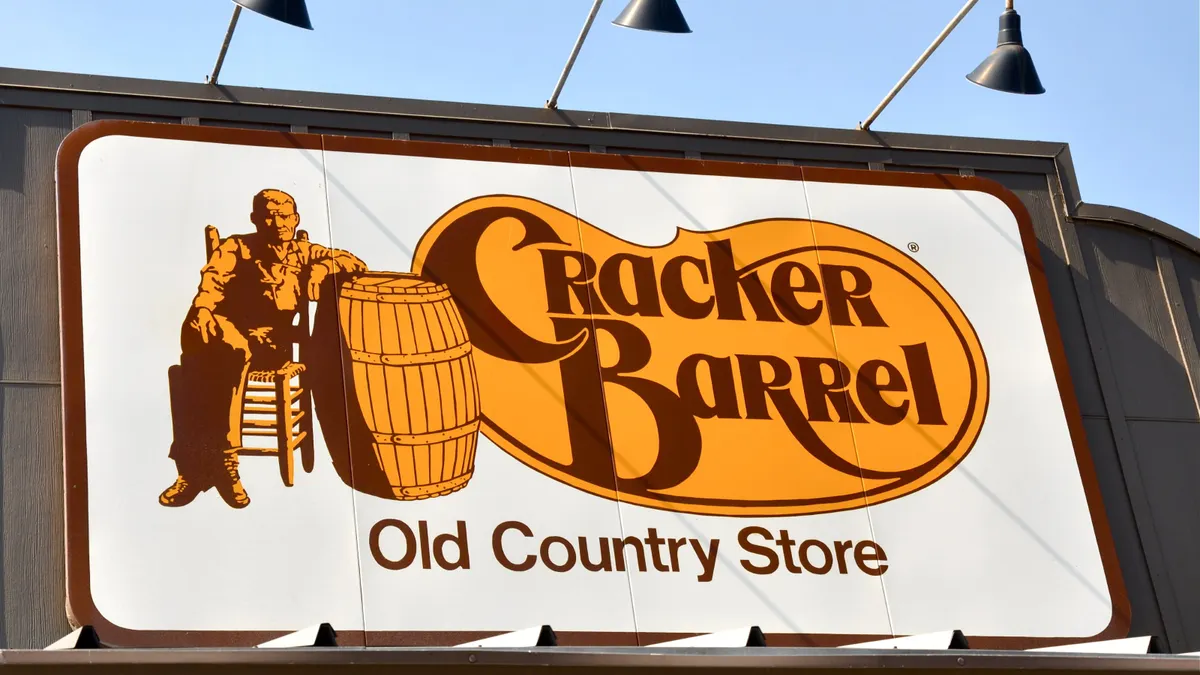As part of our coverage on the impact the coronavirus outbreak is having on the restaurant industry, we are highlighting different independent restaurants and what they are doing to survive. Have a unique strategy you'd like to share with us? Email us at [email protected].
Prior to the July relaunch of Cotton Blues Kitchen & Marketplace in Hattiesburg, Mississippi, the restaurant received a special visit by local pastor Father Tommy Conway. As restaurant staff gathered around, some sitting on bar stools and others standing at a safe distance, Conway, dressed in black and donning a mask, blessed the restaurant.
"I think even though this is a very challenging time ... it's a time for … thinking differently about keeping people safe," Conway said. "And after a tour around here, you're certainly thinking outside the box."
For Cotton Blues owner Chris Ortego, thinking outside the box meant changing the entire dining experience. After the novel coronavirus pandemic hit, Ortego closed Cotton Blues for two months and transformed the full-service restaurant into a new concept that includes a grocery market, ready-made meals, grab-and-go salads, a soup bar manned by employees with tastings available and a small dining area for guests to order chef-made meals.
But shifting to more takeout-friendly models and offering items to customers beyond a traditional sit-down isn't just limited to pandemic times, Ortego said.
"It was a trend restaurants were going in, and I think that a lot of our … eating habits have changed," Ortego said. "I felt like this was going to be a direction that we needed to head."
Nine-year-old Cotton Blues is a local institution in Hattiesburg, Ortego said, serving regulars at its high-end private dining room for special events and also offering Sunday Brunch mimosas and pancakes for customers in sweatpants.
"I still need to be something for everybody, but I need to be something for everybody in the new world of COVID-19 that we might have to put up with for the next year," Ortego said.
Converting the traditional model for COVID-19 times
For two months after the pandemic hit, Cotton Blues tried an all takeout model offering family meals and provided meals for four for $50 on a limited basis on Easter and Mother's Day, Ortego said. Staff, which consisted of about six or seven people, could only produce 55 to 60 meals even though the business had demand for even more, and this channel didn’t really pay all the bills, Ortego said.
Ortego realized his expenses weren't going down and that he needed to find a way to use 100% of his building.
So with the help of funds from the Paycheck Protection Program, Ortego instead decided to close his restaurant and renovate. Unlike many other restaurant operators, Ortego owns the building and parking lot, which also made transitioning to a remodel much easier as he didn’t need permission from a landlord.
The renovation wasn't the first time that Ortego pushed beyond the boundaries of a traditional restaurant. A couple of years after Cotton Blues opened, it also became known for its cheesecakes created by pastry chef Shaun Davis. The cheesecakes were so popular that Ortego spun it off into another business, bringing the desserts into local grocery stores and partnering with Goldbelly to provide national distribution.
This time around, however, Cotton Blues' business model changes were made to adapt to ongoing dining room restrictions that would make it difficult to return to pre-COVID-19 profits. In Mississippi, the governor loosened restrictions in May, allowing for 50% dining room capacity.
"If 20% of the general population decides they're not comfortable eating in restaurants until there's a vaccine, … that’s really devastating to our industry," Ortego said. "If we're limited at 50% [dining room capacity] it makes it almost impossible to make money."
And if this pandemic is going to stick around until next year, Ortego suspects there will be a massive economic fallout, which typically means people aren't going to dine out as much. People have also gotten used to cooking from home, especially since it is more affordable than eating out.
"It's hard to get people back into [dining out]," Ortego said.
With the current economic and health conditions, Ortego said he realized it could be at least a year before the restaurant hosts a 30-person rehearsal dinner or other events in the private dining room.
So Ortego transformed the private dining room into a small grocery store, setting up shelves and filling the rest of the building with fresh produce, grab-and-go sandwiches and salads, ready-to-heat meals and specialized items from around the country delivered from wholesaler Faire for consumers to discover, Ortego said.
"A lot of people aren't going to be traveling so we're going to try and bring a little bit of that to them here," Ortego said.
While Ortego doesn't anticipate anyone wanting to use the private dining room soon, if there was a request to hold an event after hours, it could be transformed back into a private event space, Ortego said.
For breakfast, Cotton Blues offers coffee stations, muffins, chocolate croissants, and grab-and -go sandwiches and salads available for people to take home and eat later, Ortego said. The restaurant also has a full-service bar and menu with a lot of its favorites like blackened fish tacos and blue plate specials that change depending on the day of the week. New additions include a daily soup bar that transforms into a serving station after 2 p.m. for one-pot meals. Masked and gloved staff provide tastings and serve guests these menu items in to-go containers.
Soon after it reopened, Cotton Blues added a steak program in which customers would fill a basket with items from the market that included steak provided by a local rancher, seasoning and a potato. Then a chef would cook the steak meal to the customer's liking, Ortego said.
As part of the renovation, Cotton Blues installed a kiosk where people can drive up and pick up their orders without leaving their cars. The company also offers contact-free payment options, like Apple Pay.
"Maybe we can peel off some of that drive-thru business that's so popular right now," Ortego said.
As for its huge parking lot, the team at Cotton Blues converted a portion into a 4,500-square-foot outdoor picnic area, called The Lot, where people can play games while they eat.
"I think there'll be people that would be more willing to go out to eat or hang out if they're outdoors and not just a patio that’s screened in, but a real outdoor area," Ortego said.
In addition to the physical space, Cotton Blues changed its hours as well, with breakfast — a daypart the restaurant didn’t previously offer outside of Sunday Brunch — starting at 7 a.m. and closing at 7 p.m. instead of 11 p.m.
It didn't make sense to keep the restaurant's old hours and only be busy for four hours of the day at 50% capacity, Ortego said. The restaurant removed Sunday Brunch because that business tended to come from large groups of families and friends coming after church, Ortego said.
"We have now become more busy during the work week with our family meal concepts since the opening," Ortego said.
The renovation also meant changing the full-service menu. The previous restaurant was a higher-end venue with $15 burgers and $32 prime ribs, Ortego said.
"When you can get an $8 or $10 burger to go, why get this one that is served on a fancy plate and has a busboy … and server attached to it?" Ortego said. "You can't compete to-go wise with a $15 burger when Five Guys can give you a great burger for much less. So we had to develop our food and our menu to what makes sense."
While these items are still on the menu, the burger costs $11 and the ribs are about $20.
Even with lower menu prices, Cotton Blues is better equipped to stay open and profitable even than it was before.
"I hope we don't ever get ordered to shut things down again," Ortego said. "But if we do, I think I'll be part market and I might have to shut my restaurant part of the concept down, but I'll be so much [better] positioned for meals to go and a market … so I don't have to fully shut my door down."
'Tweaking and tuning' with the customer
Before Ortego decided to change his restaurant, he sat down with each of his roughly 30 employees to tell them why he wanted to switch up the concept. He asked his staff to stick with him through it, but added that if the employee wanted to work at a traditional restaurant, there would be no hard feelings. Everyone, however, was on board and has been committed to making this new hybrid restaurant work, Ortego said.
"These guys have worked so hard to make this work, and they have such a sense of pride," Ortego said. "When they tour the customers through, the customers buy in because [the employees] buy in and they’re sold on it."
The staff's enthusiasm helped ease customers into the new model, especially if those customers missed their favorite dishes that were no longer on the menu or expected to see the old restaurant, Ortego said.
"I don’t like it when somebody's disappointed, but when I see them disappointed the first time, but then they come back in the next day to go shopping … it feels good," Ortego said.
As staff showed guests around, providing tours of the new features and explaining why the restaurant needed to change, customers quickly changed their tune. The concept has also been popular among millennials and parents who have to cook at home, Ortego said.
"Everybody felt like it was forward-thinking and wise," Ortego said.
The reopening also provided some quick lessons on what customers wanted. Cotton Blues originally offered counter service instead of having a server coming to a table in the first few days of the launch. While this model worked better for the grocery market and to-go meals, it was too awkward for dine-in guests, Ortego said. Instead, the restaurant now asks customers to get their own drinks from the fountain machine or in the refrigerated area and then servers will take food orders and bring the food, Ortego said. Food servers are also equipped with an iPad and credit card swiper and can handle twice the amount of tables as before, Ortego said.
"You just keep tweaking and tuning with your customers," Ortego. "You're silly if you think you're going to force what you want onto your customers. You have to listen to them and do what you can to meet their needs."
Initial sales from its first day exceeded Ortego's expectations given how little the company marketed or advertised. By the end of the day, very little actually passed through the kitchen, leaving the chef surprised by the total sales, Ortego said. He added that the chef didn’t realize a customer that ordered an entree from the kitchen may have also bought a pre-made salad or sandwich for a spouse.
"We just have so many different sources of revenue now, whether it be a frozen meal or a sandwich or salad that’s premade," Ortego said. "People are coming in and eating and then shopping and … maybe they get a blue plate special."
While it's still early, Ortego remains optimistic about how this concept will do in the community.
"Look, it's not proven. I mean, I need 60 days before I know there's going to be a moneymaker and it was the right decision, but based on the initial numbers that I’m seeing … this tells me that this will absolutely be financially solid," Ortego said.
And given the fact that the National Restaurant Association estimates the industry could lose $240 billion, being more financially sound will only give Ortego's restaurant a leg up.
"I think everybody who's in the hospitality industry right now is in a fight for their life over the next year or two," Ortego said.



